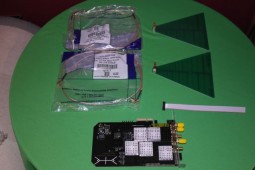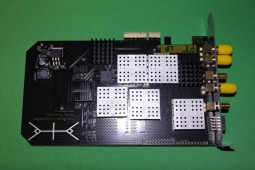Recently, the good folks at Per Vices sent us out a Noctar SDR radio card to take a look at. The Noctar card began shipping earlier this month. Normally we discuss cheap SDR radio gear at HRS, but we felt that the Noctar is a break through SDR product that would be worth investigating further. In some respects the Noctar does qualify as cheap SDR when compared to its competition in the wide coverage SDR radio category. The Noctar card has a receiver range of 100KHz through 4GHz, with the a bandwidth up 250MHz. The Noctar card alone is sold for $749 or as a kit for $849 which includes two circuit board type log periodic antennas that cover 650MHz to 6500MHz and SMA cables. The other very interesting fact about the Noctar is that it can also transmit from 100KHz to 4GHz up to a bandwidth of 250MHz. The nearest competition in this category of SDR radios can cost easily two to three times more than the Noctar. First of all, here are the basic specifications of the Noctar card.
- 100kHz – 4GHz range SDR
- Two, 12 bit, 125 MSPS ADCs
- Dual channel, 16 bit, 250 MSPS DAC
- Fully integrated, full duplex, RF frontend
- Direct conversion quadrature transceiver
- 20MHz, 0.28ppm, reference TCXO
- Altera Cyclone IV EP4CGX22C FPGA
- Digital down/up conversion on FPGA
- Open source drivers and firmware
- Includes GnuRadio Interface

The Noctar is a wideband direct conversion quadrature transceiver on a PCIe card. The PCIe form factor was chosen due to its high transfer rate of 8GBps. So it has to be mounted inside of a computer to be ato be used. Unlike most SDR radios, the Noctar is primarily sold to be used as “lab equipment” or “test equipment”. So you are not getting a plug and play SDR radio that you would get from say Winradio. Persus, etc. The Noctar is being aimed more toward SDR experimenters or for developing tools or other products based around SDR technology. However, at its heart the Noctar is still a SDR transceiver. At this writing the only drivers available for the Noctar are for GNU radio, but Per Vices is encouraging software developers to write drivers for Windows. Speaking of transmitting, we are guessing at this point that the Noctar only puts out a few milliwatts. Per Vices does make it very clear in the documentation that the end user is responsible to make sure that any transmissions made with Noctar needs to meet the regulatory standards for their country. Per Vices says that the Noctar card has a 30 day warranty against any manufacturing defects.

Ok that being said, the Noctar is still a very interesting SDR device. It can be used for everything from a SDR receiver, Spectrum Analyzer, Wifi repeater, etc, given there is software to perform these functions. This is where the software development community will come into play since the Noctars’ programming information is open source. Per Vices long range goals are to make a Noctar like device smaller and cheaper. So in some regards, products like the Noctar represent the future of SDR radio.
This the first in what we hope to be a series of articles about the Noctar. Due to some other pressing matters, we have not had time to look into the Noctar in any depth, but we hope to do so over the next few weeks and post our results here on Ham Radio Science. We will also be following any future developments for the Noctar. There is a lot to dig into on the Noctar. In the meantime we have put together a short unboxing video and first look at the Noctar Card.
We have also started a new forum for the Per Vices Noctar to keep you up to date. There is also a Yahoo Noctar Development group you can join if you would like to keep up with future developments with the Noctar.
Noctar Unboxing Video

Hello,
nice unboxing, but could be reduced to 1 Minute! Want to see the Noctar in action. How is the quality, can it really go down to 100kHz, how fast can it tune to other frequencies, is it good on all frequency ranges or just on afew, etc…
Eager to see and hear some real world stuff!!
Peter
We plan to have more later 🙂
Looks promising. Could be a serious contender to the Ettus Research USRP if it will work with the same library of applications such as those available from GnuRadio. A PCI Express interface limits the device to use with Desktop PCs. It would be nice to see a USB or GbE variation in the future.
very promising indeed, a bit of competions might shock Winradio & perseus out of their complacency
thanks for the preview
ps: i finally got with the programme and got an RTL 2832u dongle for the princely sum of £8, at that price i don’t care if it overloads, refuses to work etc!
the final straw was when my Friend G1VVP had such promising results with his
Hi, when will you publish a video and article about Noctar with real world tests?
Hi, we actually have it working in a very basic form with GNU radio. Due to some issues with our Dev Linux box and other projects, we got a bit behind in working with the card. We hope to have something up soon.
Thanks
Hi all,
Just wanted to let you know that we recently released tutorial videos on how to set up the Noctar card and a real world example we have available: how to turn Noctar into an FM receiver. (www.pervices.com)
Feel free to hit us up if you have any questions!
Why is it so expensive? I wanted to buy one, but it’s not in my price range to begin with. I hope that there will be affordable alternative kits available for buy and build. My goal is to build a SDR that will cover 1 Hz to 4 GHz or up to 10 GHz. 10 GHz is used by ham radio operators and we must find ways to get up there.
So when will you publish the in-depth test of the Pervices card?
I mean they have sent you the card in January to test it. What’s wrong?
Hi Peter from May 4th.
I am Peter from the future.
We have now July 21st and unfortunately I have to tell you that I still do not see the in-depth test.
I think this site is abandoned which is a pity.
Hi Peter from May 4th, I am Liam and I am from the far future….
I think your right.
I ordered the Noctar card and unfortunately, the DSP chain stopped working after just a couple of months. I wrote up a brief account of this at RadioReference:
http://forums.radioreference.com/software-defined-radio/272623-per-vices-noctar-woes.html
It worked well after much tinkering and learning how to use Linux and gnuradio then it just quit unexpectedly. They stopped responding to my emails after I notified them of the problem…
Does anyone have any more information on this. I mena an unboxing is nice but was there ever any review of it’s capabilities?
Just went through the Per Vices Noctar site after reading about Tom’s sad story (above). The story of a potential great company who instead decided to go for a rip-off attitude. Prices have gone double to $2500 and a shipping of 500 USD! Whaaat! Forget this company, they’ve had their chances to prove themselves. Fail.
HackRF or BladeRF next, thank you.
I have personally used multiple Noctar cards and one of the older Phi cards. They have worked great, and I look forward to the new line of radios.
That said, they put off a ton of heat and have inadequate cooling. You MUST compensate for this if using for any non-trivial lengths of time. I hope more dissipation is built into future versions of this hardware.
The other major problem is the kernel drivers on Linux. It does not efficiently communicate with the HW over PCIe spinning a single core to saturation for each tx / rx path. Reduce sample rate if you’re not running a top of the line processor with at least 4 physical cores per radio. (otherwise, you _will_ have to tune for some workloads)
I feel like this card is in same situation as the original PlayStation 3 launch. The cell processor was such a new architecture and technique that it took a while for developers to really make use of all its capability.
The Noctar radios cover huge band at awesome sample rates and transmit too. They’re worth the price at even the screwed-by-upstream-suppliers price point, and I am continually impressed by the power of these devices.
TL;DR: you MUST compensate for some design shortcomings; resulting SDR setup is high performance, exceptionally low latency, useful for a wide range of purposes.
I see the card’s RF circuitry is good,and I want to use it for a transceiver for ARTM Tier-II 2-h CPM signal. I have completed design of demodulator which could fit the FPGA. My problem is driver instability. I’m using a very powerful machine (Intel i7, 16 GB RAM) and yet GNUradio hungs sometime and I can’t get FM receiver to work. To compile the driver I have to add “#include ” to the “langford.h”. Am I doing something wrong? Could you guide me? Thank you very much in advance!